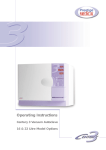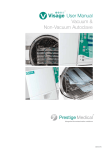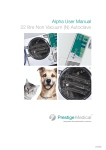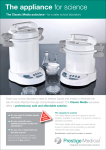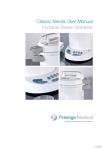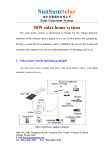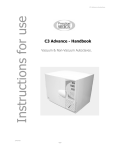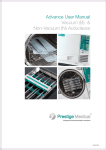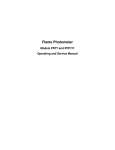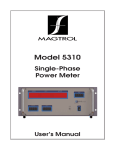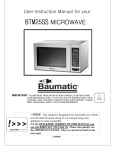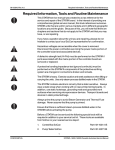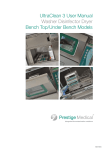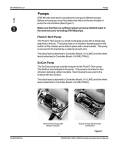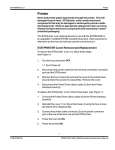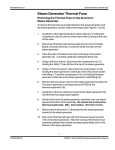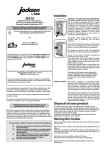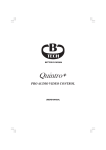Download Prestige C3Non-Vacuum Autoclave Operating
Transcript
Operating Instructions Century 3 Non-Vacuum Models English Contents P3 - Decals, displays and controls P4 - Introduction/Types of load and loading Operating symbols, Controls and Displays P5 - Operation P6 - Operation (continued) Additional Operations P7 - Essential information P8 - Troubleshooting P9 - Additional Information P10 - Specifications For Engineer Assistance Call the Autoclave Assured Helpline 01254 844118/117/116 - 682622 - 692355 (24hr) email: [email protected] Quote your model details, serial number and date of purchase when contacting Prestige Medical or your supplier S1 L Ji K S1 S5 S5 Jii B S1 E S5 L1 F1 M S2 L2 S3 S4 F2 H I C D L4 L5 L6 C2 C1 N 3 L7 L8 English Introduction Product contents will contain the following:• Autoclave with internal furniture • Handbook and Warranty card • Performance test certificate and Certificate of Conformance for pressure vessel (all UK models) • Container for waste water Thank you for choosing the Prestige Medical Century 3 autoclave. Non-vacuum cycles use the thermodynamic air displacement system Drying cycles employ an ‘open door’ system An ‘Auto-cycle Start’ option is included which allows the time of day at which a selected cycle starts, to be programmed. Before unpacking, refer to the ‘Manual Handling’ on page 9 Whilst unpacking check the unit for transit damage. If damage is found, please report this to the shipping agent immediately, in writing, and then notify your dealer. Types of load and loading • When placing on a tray, ensure items are placed on the ribs of the tray (to aid drainage), they do not touch each other, and the load does not touch the other trays or chamber in any way. • This autoclave has been qualified to sterilize solid unwrapped instruments. • A ‘responsible person’ must qualify other loads as suitable. Refer to ‘Additional Information’ • Always use the lifting device when removing trays from the autoclave as they may be hot. Long trays should be supported at their rear as they become free of the tray carrier. Do not use an unprotected hand to hold hot trays. • Maximum load per instrument tray is 2 kg. Refer to ‘Technical Specifications’ for the maximum instrument load for the autoclave • All instruments must be cleaned before sterilizing. WARNING! Refer to the instrument manufacturer about their suitability for autoclaving and the max temperature the instruments can withstand Operating Symbols, Controls and Displays The following descriptions refer to the symbols, controls, and displays shown on Page 3 of this manual. Note: Control panel for non-vacuum models is not shown. Non-vacuum control panel will not show vacuum cycle options. Symbols: S1 - IMPORTANT: Read Operating Instructions before use. Cycle Controls: H - Press to select non-vacuum cycles C1 - Non-vacuum cycle (121˚C/134˚C) for unwrapped solid instruments, with drying S2 - Do Not Use Tap Water. S4 - Fill Water tank. (Also behind main Door - L) General Controls/Operation: L1 - Display for ‘Temperature’, ‘Time’, ‘Date’, ‘Cycle Count’ The normal display mode is time. The time, date or cycle count can be selected by pressing the button (E) adjacent to the display. The selection is only valid until a cycle is started or until the unit is returned to standby mode, at which point the display will revert to the current time. C2 - Non-Vacuum cycle (121˚C/134˚C) for unwrapped solid instruments, without drying. S3 - Maximum water fill line. S5 - Hot Parts (Behind) - Do Not Touch. Display options: Note: Press button ‘H’ repeatedly to select required cycle. The cycle sequence is as follows: a) ‘C2’ and ‘134˚C’ illuminated Note: The function is selected when the LED adjacent to the button is illuminated. b) ‘C1’ and ‘134˚C’ illuminated L2 - Display for ‘Pressure’ A - n/a c) ‘C2’ and ‘121˚C’ illuminated L3 - B - Standby/ready button d) ‘C1’ and ‘121˚C’ illuminated C - Cycle start button D - Door open button E - Select time/date/cycle count display F1 - Change Temperature display - ˚c/˚f F2 - Change Pressure display - bar/psi L4 - Cycle started I L7 - Depressurization/drying - Press to select ‘Additional Drying’ H - Select cycles J - Fuses (located behind access panel) K - Printer door L - Main door L5 - Heating and air bleed L6 - Sterilizing L8 - Cycle complete G - n/a - Select ‘Additional Drying’ The following show the cycle status: After every cycle the unit automatically returns to default cycle shown as ‘C2 and 134˚C illuminated’ Adjust time/date settings (F1/F2) I n/a i - 22 litre models; ii - 16 litre models M - Water fill N - Fresh water tank drain 4 English Operation Please take time to read these instructions before using the autoclave. It is essential that the operator is correctly trained and a ‘Responsible Person’ has been assigned for the management of the autoclave. By following these simple step-by-step instructions you can ensure your instruments are correctly sterilized every time. 1. Installation Ensure the unit is placed on a strong, flat and level surface. • Set Year (hundreds); Month; Day; Minutes; Hours; by pressing button (E) up and (F1) down and button (F2) to accept • The unit returns to the ready mode when ‘hours’ are accepted To check if the unit is level, pour half a cup of water into the chamber. The water should flow towards the rear of the chamber, not out of the front. 5. Ready Press button (B) to set the autoclave in ‘ready mode’. The LED next to button (B) will go out. Note: When in ‘ready mode’, the boiler and chamber are kept warm. 6. Water fill - DO NOT USE TAP WATER Before using the autoclave for the first time fill with water. WARNING! The autoclave is heavy, at least two people will be needed to lift it. Press button (D) to open the door. Pour water into the fill spout (M) until it reaches ‘Maximum’ line (S3). Water capacity is 3.7 litres. 2. Connection Plug the unit into a mains outlet socket of the correct type and rating. Refer to duplicate rating plate located inside the printer door (K). After a few seconds the LED next to button (B) illuminates. When the low water indicator illuminates (S4), top-up with water. Always use de-ionised, distilled or sterile water as recommended. Never use tap water WARNING! The mains outlet MUST BE EARTHED (GROUNDED) The mains plug should always be easily accessible as it is to be relied upon as “the means of disconnection” 7. Loading Refer to ‘Type of loads and loading’ on page 4 and ‘Specifications’ on page 10 for the maximum permissible load. Failure to follow instructions may cause the unit to malfunction and result in an unsuccessful cycle. 3. Single Use Water system This unit has a ‘single use’ water system designed to prevent the recycling of any contaminants which may be present on the instruments being sterilized. Before loading, ensure instruments are cleaned and rinsed. Ensure the ‘Waste Water Container’ is checked regularly to prevent overflowing. The container should be emptied when the waste water reaches the ‘max’ line. To empty container, undo screw cap and carefully remove the steam condensing coil, which passes through the cap. Place on a heat resistant surface whilst emptying the container. Always use the instrument trays which are supplied. Load instruments so that they do not touch other instruments or the chamber and are resting on the ribs of the tray. 60mm 8. Door closing Once the trays are in place close the door by pushing until a ‘click’ is heard. The LED next to the Door Open button (D) illuminates. Use the carry handle to support the container when emptying. Replace steam condensing coil and cap, ensuring it is screwed on securely. Note: Before using for the first time and after emptying, always add approximately 60mm of water to the ‘waste container’, ensuring the steam condensing coil is fully immersed in water at all times. The ‘waste water container’ can be located in any appropriate place although care should be taken that it cannot be knocked over. WARNING! Waste water and steam condensing coil may be hot - care should be taken at all times 4. Setting Date and time Date and time are set in the following sequence: Note: The 24hr clock is used. Year (tens); Year (hundreds); Month; Day; Minutes; Hours: • Set autoclave in “ready mode” by pressing ready button (B). LED next to button (B) will go out. • Press and hold button (E) for 5 seconds • Set year (tens) by pressing button (E) up and (F1) down. Press button (F2) to accept 5 English Operation (continued) Additional Operations 9. Cycle options After each cycle the unit returns to the default cycle ‘C1’-134˚C/3min Vacuum cycle for linen loads, wrapped, pouched, solid or hollow instruments, with drying. Auto-cycle Start The unit can be programmed to enable any cycle to be started at any time of day when the unit is unattended. This option is recommended particularly when the operator performs an ‘Air leak detection test’. Cycle options are: H - Press to select non-vacuum cycle • Set autoclave in ‘standby’ by pressing ready button (B). LED next to button (B) will illuminate. C1 - Non-vacuum cycle (121˚C/134˚C) for unwrapped solid instruments, with drying. • Press and hold button (E) for 6 seconds and release. The ‘time display’ (L1) will flash. the default time of 06.30 will be shown. C2 - Non-Vacuum cycle (121˚C/134˚C) for unwrapped solid i instruments, without drying. • Press (F2) to accept. If another time is required for the auto-cycle start, change minutes then hours; by pressing button (E) up and (F1) down and button (F2) to accept. Note: Press button ‘H’ repeatedly to select required cycle. The cycle sequence is as follows: • The unit returns to the ready mode and the ‘time display’ (L1) continues to flash. You can scroll through the settings as a check. a) ‘C2’ and ‘134˚C’ illuminated • Select the required sterilizing cycle using buttons (G), (H), and (I). b) ‘C1’ and ‘134˚C’ illuminated • Press the start button (C). The ‘start’ LED (C), the ‘door’ LED (D) and the ‘time display’ (L1) will flash. c) ‘C2’ and ‘121˚C’ illuminated • The selected cycle will start when the programmed start time is reached. d) ‘C1’ and ‘121˚C’ illuminated • To abort a timed cycle press the standby button (B). I - Press to select ‘Additional drying’ These options are available on all cycles and maybe selected before starting the cycle, or once the cycle is completed. Note: If the unit is used in a very cold environment, water vapour may be seen coming from the cooling fan. This is normal and will only last for a few minutes. To select before starting a cycle: i) Press button (I) once - L4 illuminates to indicate 10 additional minutes. ii) Press (I) a second time - L4 & L5 illuminates to indicate 20 additional minutes. iii) Press (I) a third time - L4, L5 & L6 illuminates to indicate 30 additional minutes. iv) Press (I) a fourth time - cancels ‘Additional Drying’. v) Select, then start the required cycle - See ‘10’. The temperature selected LED will flash throughout the cycle to indicate ‘Additional Drying’ has been selected. To select after a cycle has been completed: i) With the door CLOSED, press and hold button (I) for 10 seconds L4 illuminates to indicate 10 additional minutes. ii) Press (I) twice, holding on second press for 10 seconds (L4 & L5 illuminates to indicate 20 additional minutes). iii) Press (I) three times, holding on third press for10 seconds (L4, L5 & L6 illuminates to indicate 30 additional minutes). iv) L7 flashes to indicate ‘Additional Drying’ has started. 10. Start cycle Press button (C) to start a fully automatic cycle. A visual display shows the stages of the cycle: Stage 1 - Cycle started (L4) Stage 2 - Heating and air bleed (L5) Stage 3 - Sterilizing (L6) Stage 4 - Depressurisation/drying (L7) Stage 5 - Cycle complete (L8) 11. Opening door At the end of a cycle the buzzer sounds 3 times. Press button (D) to open the door, allowing access to the load. 6 English Essential Information To ensure the autoclave continues to operate correctly, it is important to follow the following points and to carry out the necessary care and maintenance procedures as specified. Do ensure that.... Routine Care and Maintenance ... you read and follow these operating instructions. WARNING! Disconnect the autoclave from the mains power supply before cleaning. ... the load is suitable for sterilization and the cycle selected. ... the load can be sterilized at the selected temperature. ... the load has been cleaned. Daily maintenance ... the load has been rinsed thoroughly in clean water prior to sterilization to avoid any chemical residues left after cleaning. This product is not a washing / cleaning machine. Gasket THE GASKET MUST BE CLEANED ON A DAILY BASIS, BEFORE USING THE AUTOCLAVE. ... when placing instruments on trays, ensure that they are placed on the ribs of the tray (to help drainage), that they do not touch each other and that the height of the load does not interfere with the tray or chamber above. Wipe exposed surface of the gasket and the surface of the vessel with warm soapy water using a damp cloth. Wipe both the gasket and the vessel again with water using a damp cloth to remove residual soap. .... only distilled, de-ionised or sterile water is used (as recommended). ... the autoclave is in a draught free area. Gasket Replacement ... the autoclave cooling fan outlet is at least 100mm from any nearby surface. If the nearby surface is cold, then condensation may occur. Should the gasket develop a persistent leak it should be removed, cleaned thoroughly in warm soapy water and shaken dry. Do not wipe with a cloth. The door plate must also be cleaned. ... the autoclave is not installed in an enclosed cupboard space’ If the leak persists you should obtain and fit a new seal. ... all other exterior product panels are 50mm clear of adjoining surfaces to allow air circulation. To remove the gasket, undo the dome nuts in the centre of the door, remove the plate and gasket assembly and remove the gasket from the plate. ... the autoclave is positioned so that the rear is not accessible to personnel and that it is not directly in front of an electrical outlet so as to allow the over-pressure release valve to operate safely. During re-assembly, place new sealing washers under the heads of the dome nuts. ... door is left ajar when not in use. DO NOT over-tighten as this may damage the thread. ... you quote model/serial numbers (which are located inside the printer door) and date of purchase in all correspondence. Ensure that the entry port plugs align with the holes in the cast lid. ... only qualified personnel service the autoclave. Every 250 cycles Clean the autoclave using the using Autoclave Cleaning Kit - Part No. 289138A It is recommended that a Chemical Indicator strip be used every cycle to verify that the sterilizing cycle is effective. If the Chemical Indicator strip fails to change colour repeat cycle. If it still fails to change colour then arrange for a service. WARNING! Failure to perform these procedures may result in the unit showing UD01on the display (UD01 indicates that the unit may have become contaminated and could fail to operate correctly). Do Not... ... lose this handbook. ... add any chemicals whatsoever to the water. Exterior surfaces (as required) ... attempt to sterilize volatile substances, toxic materials or other unsuitable loads. Refer to your ‘Responsible Person’ for advice. Exterior surfaces should be cleaned with warm soapy water using a damp cloth. ... place the autoclave in direct sunlight. For persistent marks, use a gentle cream cleaner. ... place the autoclave on heat sensitive surfaces. ... use inappropriate cleaning materials. Fresh water tank / Waste Water Container ... drop or abuse the autoclave. On a monthly basis, fully drain the water tank and leave overnight (use Autoclave Cleaning Kit - Part No. 289138). Drain, refill with fresh water, and repeat this twice more to remove any residue. ... use in areas of risk associated with flammable materials or gases. ... remove the casing or attempt to service or repair the autoclave. Always use de-ionised, distilled or sterile water, as recommended. Never use tap water Routine maintenance On a weekly basis check the waste water tube and condensing coil for defects. Ensure this is done when the unit is cold Every 3 months check the calibration - refer to the service manual Annually replace the water filters 7 English Troubleshooting Should a fault occur a visual and audible indication will be given. The nature of the fault can be determined by reference to the fault guide below. The recovery sequence allows access to any instruments within the autoclave and is the first step when rectifying a fault mode. User Message Cause Remedy UOD1: Contamination 1. Conduct routine maintenance procedures 2. If fault persists Engineer call-out required Low water LED (S4) Insufficient water in the tank to run a cycle 1. Press button (B) twice. 2. Top-up with water ‘Door’ illuminates on display (L2) Cycle start button pressed whilst door is open 1. Close door and try again 01: Power failure during cycle 1. Recovery sequence ‘i’ 2. Check power supply - repeat cycle b02/d02 Annex A Failure (time or temperature) 1. Recovery sequence ‘i’ 2i.Clean gasket and chamber face - repeat cycle (b/d02) 2ii.Check and reset clock - repeat cycle (t02) 03: Air bleed has not been successful 1. Recovery sequence ‘i’ 2. Clean gasket and chamber face - repeat cycle 04: N/A N/A 05: N/A N/A t02: 06: N/A 07: Sensor fault - Thermistor 1. Recovery sequence ‘ii’ - repeat cycle. 2. Engineer call-out required N/A 08: N/A N/A 09: N/A N/A 10: Water in boiler 1. Recovery sequence ‘iii’ 2. Repeat cycle 11: Air filter blocked 1. Recovery sequence ‘i’ 2. Replace air filter - Engineer call-out required 13: Water fill time out 1. Recovery sequence ‘i’ 2. Drain water from autoclave and refill with distilled/de-ionised/sterile water - repeat cycle 14: Sensor fault - Chamber Probe 1. Recovery sequence ‘ii’ - repeat cycle. 2. Engineer call-out required 15. N/A N/A For Engineer Assistance Call the Autoclave Assured Helpline 01254 844118/117/116 - 682622 - 692355 (24hr) email: [email protected] Recovery Sequence (allows instruments to be removed from the unit) Recovery Sequence ‘i’ Press (B) -‘Stabilize’ (no ‘flashing’, no ‘beeping’) Press (B) - ‘Recover’ Recovery Sequence ‘ii’ Press (B) -‘Stabilize’ (no ‘flashing’, no ‘beeping’) NB: Cannot proceed (door not enabled) Service Required Recovery Sequence ‘iii’ Press (B) -‘Stabilize’ (no ‘flashing’, no ‘beeping’) Press (B) to enter ‘Ready’ state The Recovery sequence will allow the selected sterilizing cycle to be completed before the boiler flushes and any remaining air is bled from the chamber. Once this sequence has been completed the unit holds for 60 secs or, until the internal temperature falls to 88˚C, before the door can be opened and a continuous beeping alert sounds. Important Before restarting a cycle, check the mains plug is fully inserted into the mains outlet socket and the outlet is of the earthed/grounded type. Should all power be lost the door cannot be opened until power is restored. Should an internal power failure occur, the door cannot be opened until a service has been carried out. Should it be clear that an indicating device is suspect, a service will be required to correct the condition. Should a safety feature operate, unplug the unit and call for a service - do not attempt to correct the fault. Primary safety features: Two primary features have been fItted - a pressure release valve and a boiler over temperature safety cutout. 8 English Additional Information Operator: The person who is assigned to use the autoclave Accessories: 289083 - Printer (optional printer can be fitted by the user) Responsible Person: The person who is responsible for the management of the equipment, load assignment, care and maintenance. This person is also responsible for ensuring that all applicable health and safety regulations are applied including those relating to the pressure vessel. This person must verify that only suitably qualified persons undertake repair and maintenance work other than that described under “care and maintenance” within this handbook. 279001 - Printer Roll Replacement 279006 - 282 mm Instrument tray 279005 - 430mm Instrument tray 279007 - Instrument Tray / Rack Lifter For removal of trays and racks 279011 - Sealing gasket 250 mm diameter chamber 274210 - Waste Water Container Qualified Person: A person who is qualified by training or experience to a recognised level in respect of the work to be undertaken. 279418 - Water Distiller For distilling tap water for use in the unit Service: Calibration and maintenance as required. 289138 - Autoclave Cleaning kit For cleaning the autoclave to ensure continued operation Manual Handling: Due to the weight of the unit two people are required when unpacking or moving the product. UNPACKING: When lifting the unit out of the box ensure there is one person on either side of the unit. Lift out of the box and place on work surface. POSITIONING: Start lifting by holding the unit below the printer door. As clearance is gained, lift at the other corners. Place in position, and release in the reverse order to lifting. NOTE: Always drain the water tank before moving. Before moving always allow 30 minutes after use for the unit to cool down Warranty: Prestige Medical will, in the first 12 months from the date of purchase, repair or replace free of charge any parts which prove to be defective in workmanship and/or materials. The heating element (only) is covered by a lifetime guarantee. Prestige Medical will not be so liable in the event that the purchaser has failed to adhere to the instructions contained herein or if the autoclave has been abused, interfered with, altered, repaired or serviced by any unauthorised party. This may also result in the protection provided by the equipment being impaired. This warranty excludes the gasket, all internal furniture and consumables. Consumer’s statutory rights are not affected. Cleaning materials: - mild washing up liquid. - non-abrasive cream cleaner. - disinfectant diluted in water - Autoclave Cleaning Kit - 289138 The policy of Prestige Medical is one of continuous development and as such reserve the right to change the specification of the models and items illustrated and described herein at any time Product decontamination. Should the unit require repair, it must be decontaminated in accordance with a recognised procedure prior to return or on-site repair. A statement of equipment contamination status must be available with the product. (Details of a suitable procedure is available on request.) Approvals: Approvals are all model specific. However, the following standards apply in whole or part: • Medical Devices Directive (MDD 93/42/EEC) • Electro Magnetic Compatibility Directive • European Sterilizer Standard (prEN13060) • Pressure vessel to ASME Section 8 • BS EN 61010 Parts 1/2 • UL/CSA 3101 Spares: Only those spare parts supplied or specified by Prestige Medical should be used in the maintenance of the autoclave. Use of unauthorised parts will invalidate any warranty and may adversely affect the performance and safety of the unit. 9 English Specifications Chamber Capacities 16 litre 22 Litre Overall product width 480mm 480mm Overall product height 410mm 410mm Overall product length 440mm 560mm Unpacked weight 42kg (max) 43kg (max) Chamber diameter 250mm 250mm Chamber lengths 330mm 430mm Tray/rack capacity/length 6@282mm 6@430mm Max instrument length 300mm 450mm Max instrument load 2kg 6kg Sterilizing temp/time 134˚C/3mins 134˚C/3mins 121˚C/16mins 121˚C/16mins Fuses: Fuses are located under a access panel on the rear of the product. WARNING! Disconnect the autoclave from the mains power supply before changing fuses. Only qualified personnel should replace fuses. Fuse Type: M12A 32 x 6.3mm ceramic sand filled (230v) Mains plug top fuse (User replaceable) F13A to BS1362 UK only. Rating: All products are rated for intermittent use, continuously Heater: Cast into boiler Temperature cutout: Bi-metallic type with manual only reset. This operates at170˚C. Pressure release valve (CE Marked): Operates at 2.76 bar. Accumulation is <10% Maximum single fault temperature: 141˚C determined by pressure release valve. Over-voltage category: Group II Operating pressure (minimum) 2.05bar 2.05bar Voltage/wattage 230v/2200w 230v/2200w Pollution degree: Group 2 Frequency 50 - 60Hz 50 - 60Hz Insulation: Class 1 NB: The overall cycle time will increase as the mains supply voltage decreases. Chamber component materials Vessel: Stainless steel - 304 - S15 Boiler: Aluminium - LM25 Lid: Aluminium - LM25-TF Door Plate: Stainless steel - 304 - S15 Environmental conditions: Indoor use at an altitude of up to 2,000m Ambient temperature range +10˚C to +40˚C Maximum relative humidity 80% for temperatures up to 31˚C, decreasing linearly to 50% at 40˚C. Mains supply voltage range 207 to 254 volts (230v) or 99 to 121 volts (110v) Safety Shutdown: Refer to ‘temperature cut out’. This should only be reset by a qualified person Storage: When leaving the unit standing idle for any length of time, drain the water tank especially if there is a possibility of the room temperature dropping below freezing point Packaging: Packing materials used have been selected for ease of recycling. Please ensure you use the correct waste disposal system for disposal of packing materials 10 English Notes 11 For Engineer Assistance Call the Autoclave Assured Helpline 01254 844118/117/116 - 682622 - 692355 (24hr) email: [email protected] Model no. Serial no. Vessel Rating Plate (Duplicate) Date of Purchase / Supplier ISO 9001 0086 No. FM 31988 EN 46001 Cert. No. 1354 P.O.Box 154, Clarendon Road, Blackburn, Lancs, BB1 9UG. England. Tel: +44 (0)1254 682622 Fax: +44 (0)1254 682606 Prestige Medical Limited is registered in England No. 2826793 12 Ref: 274209A Quote your model details, serial number and date of purchase when contacting Prestige Medical or your supplier












